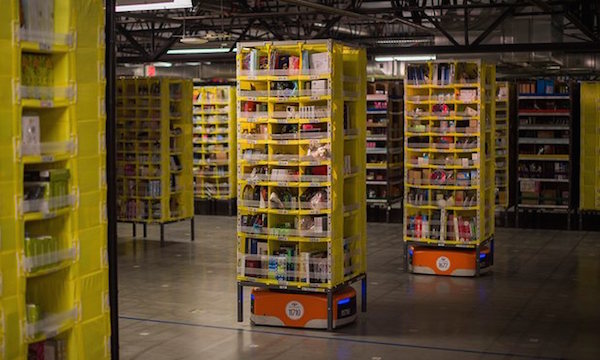


05/26/2017
Wired’s video below, sketching out the automated future vis-a-vis jobs, uses the idea that smart machines are helpful collaborative robots, or “co-bots” that allow humans to work more efficiently. But that relationship will end when the machines become able to replicate human abilities and perform them far more cheaply.
One of the bumps along the road for roboticists is the amazing human hand, which allows Amazon’s pickers to pack boxes to be shipped to customers. Interestingly, Amazon has scheduled another picking challenge, where robot technology teams will compete for a big cash prize and a possible deal with the company.
Below, Amazon’s orange Kiva robots scoot under appropriate racks of merchandise to bring the ordered items to a human picker who packs the boxes for shipping.

Below are details about Amazon’s Robotics Challenge which will take place July 27-30 in Japan. The search is for a machine that “can recognize objects, grab them, execute tasks, detect errors and recover as needed” which sounds a lot like the picker job. Clearly Amazon’s goal is to find a machine that can at least partially replace the company’s human pickers.
With robotics technology advancing so rapidly, it seems unwise for the US government to continue importing immigrant workers. They will soon be unneeded, if they aren’t already.
Amazon is offering $250,000 to a team that comes up with an advanced robot for its warehouses, CNBC, May 10, 2017Amazon is offering $250,000 to teams who invent robots that could potentially work in their massive fulfillment centers, and it has chosen 16 finalists for a tournament it is organizing later this year, the company said on Wednesday.
The e-commerce giant is running its third annual Robotics Challenge this year in July in Japan and has picked finalists from across the world. There are competitors from major U.S. institutions such as the Massachusetts Institute of Technology, Princeton and Carnegie Mellon University.
Participants will need to show that their robot software and hardware can recognize objects, grab them, execute tasks, detect errors and recover as needed. The robots will be scored by how many items are successfully picked and stowed in a fixed amount of time, Amazon said.
The Seattle-based firm has been working on making the whole process from placing an order to delivery more efficient as it looks to cut down the time a person has to wait for a package. One major part of the process is choosing and packing items in a fulfillment center.
Amazon currently has more than 80,000 automated robots in its warehouses globally. The robots currently use wheeled systems which carry and transport products around a fulfillment center. But it is now looking for more advanced mechanisms.
“Commercially viable automated picking in unstructured environments still remains a difficult challenge,” an explanation on the Amazon Robotics website reads.
This refers to a robot being able to roam a warehouse where items may not be in an order that can be easily decoded by software. While the current wheeled robots are limited, Amazon is hoping its robotics challenge could uncover a system to take their warehouses to the next level.
Amazon bought a company in 2012 called Kiva which created these wheeled robots for warehouses. In 2015, Kiva’s name was officially changed to Amazon Robotics. Under this brand, Amazon is attempting to create next generation robots.
Its fulfillment centers are just one part of the puzzle when it comes to fast deliveries for Amazon. The company is also testing deliveries by drone, for example, to speed up deliveries.